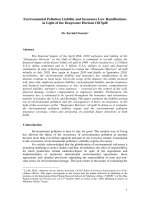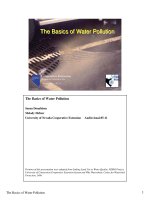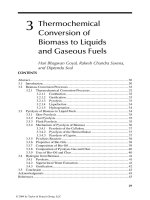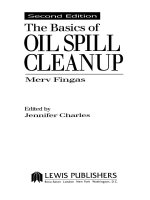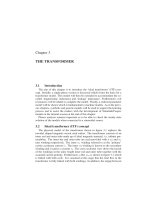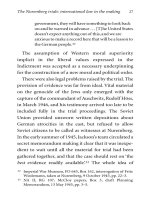The Basics of Oil Spill Cleanup - Chapter 3 pps
Bạn đang xem bản rút gọn của tài liệu. Xem và tải ngay bản đầy đủ của tài liệu tại đây (463.95 KB, 8 trang )
©2000 by CRC Press LLC
CHAPTER
3
Types of Oil and their Properties
Oil is a general term that describes a wide variety of natural substances of plant,
animal, or mineral origin, as well as a range of synthetic compounds. The many
different types of oil are made up of hundreds of major compounds and thousands
of minor ones. As their composition varies, each type of oil or petroleum product
has certain unique characteristics or properties. These properties influence how the
oil behaves when it is spilled and determine the effects of the oil on living organisms
in the environment. These properties also influence the efficiency of cleanup oper-
ations. This book deals specifically with crude oils and petroleum products derived
from crude oils. The chemical composition and physical properties of these oils are
described in this chapter.
THE COMPOSITION OF OIL
Crude oils are mixtures of hydrocarbon compounds ranging from smaller, vol-
atile compounds to very large, non-volatile compounds. This mixture of compounds
varies according to the geological formation of the area in which the oil is found
and strongly influences the properties of the oil. For example, crude oils that consist
primarily of large compounds are viscous and dense. Petroleum products such as
gasoline or diesel fuel are mixtures of fewer compounds and thus their properties
are more specific and less variable.
Hydrocarbon compounds are composed of hydrogen and carbon, which are
therefore the main elements in oils. Oils also contain varying amounts of sulphur,
nitrogen, oxygen, and sometimes mineral salts, as well as trace metals such as nickel,
vanadium, and chromium.
In general, the hydrocarbons found in oils are characterized by their structure.
The hydrocarbon structures found in oil are the saturates, olefins, aromatics, and
polar compounds, some examples of which are shown in Figure 5.
©2000 by CRC Press LLC
The
saturate group
of components in oils consists primarily of alkanes, which
are compounds of hydrogen and carbon with the maximum number of hydrogen
atoms around each carbon. Thus, the term “saturate” is used because the carbons
are saturated with hydrogen. The saturate group also includes cyclo-alkanes, which
are compounds made up of the same carbon and hydrogen constituents, but with
the carbon atoms bonded to each other in rings or circles. Larger saturate compounds
are often referred to as
waxes
.
The
olefins
, or unsaturated compounds, are another group of compounds that
contain fewer hydrogen atoms than the maximum possible. Olefins have at least one
Figure 5
Chemical compounds in oils.
©2000 by CRC Press LLC
double carbon-to-carbon bond that displaces two hydrogen atoms. Significant
amounts of olefins are found only in refined products.
The
aromatic compounds
include at least one benzene ring of six carbons. Three
double carbon-to-carbon bonds float around the ring and add stability. Because of this
stability, benzene rings are very persistent and can have toxic effects on the environment.
The most common smaller and more volatile compounds found in oil are often
referred to as
BTEX
, or benzene, toluene, ethyl-benzene, and xylenes.
Polyaromatic
hydrocarbons
, or
PAHs
, are compounds consisting of at least two benzene rings.
PAHs make up between 0 and 60% of the composition of oil.
Polar compounds
are those that have a significant molecular charge as a result
of bonding with compounds such as sulphur, nitrogen, or oxygen. The “polarity” or
charge that the molecule carries results in behaviour that, under some circumstances,
is different from that of unpolarized compounds. In the petroleum industry, the
smallest polar compounds are called “
resins
,” which are largely responsible for oil
adhesion. The larger polar compounds are called “
asphaltenes
” because they often
make up the largest percentage of the asphalt commonly used for road construction.
Asphaltenes often have very large molecules and, if in abundance in an oil, they
have a significant effect on oil behaviour. This will be discussed in Chapter 4.
The following are the oils used in this book to illustrate the fate, behaviour, and
cleanup of oil spills:
• gasoline — as used in automobiles
• diesel fuel — as used in trucks, trains, and buses
• a light crude oil — as produced in great abundance in western Canada or Louisiana
• a heavy crude oil — as imported to North America from Arabic countries or similar
to that produced off the coasts of Newfoundland and California
• an intermediate fuel oil (IFO) — a mixture of a heavy residual oil and diesel fuel
used primarily as a propulsion fuel for ships (the intermediate refers to the fact
that the fuel is between a diesel and a heavy residual fuel)
• bunker fuel — such as Bunker C which is a heavy residual fuel remaining after
the production of gasoline and diesel fuel in refineries and often used in heating
plants
• crude oil emulsion — such as an emulsion of water in a medium crude oil
Typical amounts of hydrocarbon compounds found in these oils are shown in
Table 4.
Properties of Oil
The properties of oil discussed here are viscosity, density, specific gravity, sol-
ubility, flash point, pour point, distillation fractions, interfacial tension, and vapour
pressure. These properties for the oils discussed in this book are listed in Table 5.
Viscosity
is the resistance to flow in a liquid. The lower the viscosity, the more
readily the liquid flows. For example, water has a low viscosity and flows readily,
whereas honey, with a high viscosity, flows poorly. The viscosity of the oil is largely
determined by the amount of lighter and heavier fractions that it contains. The greater
©2000 by CRC Press LLC
the percentage of light components such as saturates and the lesser the amount of
asphaltenes, the lower the viscosity.
As with other physical properties, viscosity is affected by temperature, with a
lower temperature giving a higher viscosity. For most oils, the viscosity varies as
the logarithm of the temperature, which is a very significant variation. Oils that flow
readily at high temperatures can become a slow-moving, viscous mass at low tem-
peratures. In terms of oil spill cleanup, viscosity can affect the oil’s behaviour.
Viscous oils do not spread rapidly, do not penetrate soil as readily, and affect the
ability of pumps and skimmers to handle the oil.
Table 4 Typical Composition of Some Oils and Petroleum Products
Group
Compound
Class
(%)
Gasoline Diesel
Light
Crude
Heavy
Crude IFO
Bunker
C
Saturates 50 to 60 65 to 95 55 to 90 25 to 80 25 to 35 20 to 30
alkanes 45 to 55 35 to 45
cyclo-
alkanes
5 30 to 50
waxes 0 to 1 0 to 20 0 to 10 2 to 10 5 to 15
Olefins 5 to 10 0 to 10
Aromatics 25 to 40 5 to 25 10 to 35 15 to 40 40 to 60 30 to 50
BTEX 15 to 25 0.5 to 2.0 0.1 to 2.5 0.01 to 2.0 0.05 to 1.0 0.00 to 1.0
PAHs 0 to 5 10 to 35 15 to 40 40 to 60 30 to 50
Polar
Compounds
0 to 2 1 to 15 5 to 40 15 to 25 10 to 30
resins 0 to 2 0 to 10 2 to 25 10 to 15 10 to 20
asphaltenes 0 to 10 0 to 20 5 to 10 5 to 20
Metals 30 to 250 100 to 500 100 to 1000 100 to 2000
Sulphur 0.02 0.1 to 0.5 0 to 2 0 to 5 0.5 to 2.0 2 to 4
Photo 18
This shows the appearance of highly weathered Bunker C 25 years after it was
spilled and washed up onto this beach. (Environment Canada)
©2000 by CRC Press LLC
Density
is the mass (weight) of a given volume of oil and is typically expressed
in grams per cubic centimetre (g/cm
3
). It is the property used by the petroleum
industry to define light or heavy crude oils. Density is also important because it
indicates whether a particular oil will float or sink in water. As the density of water
is 1.0 g/cm
3
at 15°C and the density of most oils ranges from 0.7 to 0.99 g/cm
3
,
most oils will float on water. As the density of seawater is 1.03 g/cm
3
, even heavier
oils will usually float on it. The density of oil increases with time, as the light
fractions evaporate.
Table 5 Typical Oil Properties
Property Units Gasoline Diesel
Light
Crude
Heavy
Crude
Intemediate
Fuel Oil
Bunker
C
Crude Oil
Emulsion
Viscosity mPa.s at
15°C
0.5 2 5 to 50 50 to
50,000
1000 to
15,000
10,000 to
50,000
20,000 to
100,000
Density g/mL at
15°C
0.72 0.84 0.78 to
0.88
0.88 to
1.00
0.94 to 0.99 0.96 to
1.04
0.95 to 1.0
Flash Point °C –35 45 –30 to 30 –30 to 60 80 to 100 >100 >80
Solubility in
Water
ppm 200 40 10 to 50 5 to 30 10 to 30 1 to 5 –
Pour Point °CNR–35 to
–1
–40 to 30 –40 to 30 –10 to 10 5 to 20 >50
API Gravity 65 35 30 to 50 10 to 30 10 to 20 5 to 15 10 to 15
Interfacial
Tension
mN/m at
15°C
27 27 10 to 30 15 to 30 25 to 30 25 to 35 NR
Distillation
Fractions
% distilled
at
100°C 70 1 2 to 15 1 to 10 ––NR
200°C 100 30 15 to 40 2 to 25 2 to 5 2 to 5
300°C 85 30 to 60 15 to 45 15 to 25 5 to 15
400°C 100 45 to 85 25 to 75 30 to 40 15 to 25
residual 15 to 55 25 to 75 60 to 70 75 to 85
NR = not
relevant
Photo 19
Emulsified oil is very viscous and dense. (Environment Canada)
©2000 by CRC Press LLC
Occasionally, when the density of an oil becomes greater than the density of
fresh- or seawater, the oil will sink. Sinking is rare, however, and happens only with
a few oils, usually residual oils such as Bunker C. Significant amounts of oil have
sunk in only about 25 incidents out of thousands.
Another measure of density is
specific gravity
, which is an oil’s relative density
compared with that of water at 15°C. It is the same value as density at the same
temperature. Another gravity scale is that of the American Petroleum Institute (API).
The
API gravity
is based on the density of pure water, which has an arbitrarily
assigned API gravity value of 10° (10 degrees). Oils with progressively lower specific
gravities have higher API gravities.
The following is the formula for calculating API gravity:
API gravity = [141.5 ÷ (density at 15.5°C)] – 131.5
Oils with high densities have low API gravities and vice versa. In the United
States, the price of a specific oil may be based on its API gravity, as well as other
properties of the oil.
Solubility
in water is the measure of how much of an oil will dissolve in the
water column on a molecular basis. Solubility is important in that the soluble
fractions of the oil are sometimes toxic to aquatic life, especially at higher concen-
trations. As the amount of oil lost to solubility is always small, this is not as great
a loss mechanism as evaporation. In fact, the solubility of oil in water is so low
Photo 20
Bunker C, which is dense and viscous, was spilled in this sewer. (Environment
Canada)
©2000 by CRC Press LLC
(generally less than 100 parts per million) that it would be the equivalent of approx-
imately one grain of sugar dissolving in a cup of water.
The
flash point
of an oil is the temperature at which the liquid gives off sufficient
vapours to ignite upon exposure to an open flame. A liquid is considered to be
flammable if its flash point is less than 60°C. There is a broad range of flash points
for oils and petroleum products, many of which are considered flammable, especially
when fresh. Gasoline, which is flammable under all ambient conditions, poses a
serious hazard when spilled. Many fresh crude oils have an abundance of volatile
components and may be flammable for as long as 1 day until the more volatile
components have evaporated. On the other hand, Bunker C and heavy crude oils
generally are not flammable when spilled.
The
pour point
of an oil is the temperature at which it takes longer than a
specified time to pour from a standard measuring vessel. As oils are made up of
hundreds of compounds, some of which may still be liquid at the pour point, the
pour point is not the temperature at which the oil will no longer pour. The pour
point represents a consistent temperature at which an oil will pour very slowly and
therefore has limited use as an indicator of the state of the oil. In fact, pour point
has been used too much in the past to predict how oils will behave in the environment.
For example, waxy oils can have very low pour points, but may continue to spread
slowly at that temperature and can evaporate to a significant degree.
Distillation fractions
of an oil represent the fraction (generally measured by
volume) of an oil that is boiled off at a given temperature. This data is obtained on
most crude oils so that oil companies can adjust parameters in their refineries to
handle the oil. This data also provides environmentalists with useful insights into
the chemical composition of oils. For example, while 70% of gasoline will boil off
at 100°C, only about 5% of a crude oil will boil off at that temperature and an even
smaller amount of a typical Bunker C. The distillation fractions correlate strongly
to the composition as well as to other physical properties of the oil.
The
oil/water interfacial tension
, sometimes called surface tension, is the force
of attraction or repulsion between the surface molecules of oil and water. Together
with viscosity, surface tension is an indication of how rapidly and to what extent an
oil will spread on water. The lower the interfacial tension with water, the greater the
extent of spreading. In actual practice, the interfacial tension must be considered
along with the viscosity because it has been found that interfacial tension alone does
not account for spreading behaviour.
The
vapour pressure
of an oil is a measure of how the oil partitions between
the liquid and gas phases, or how much vapour is in the space above a given amount
of liquid oil at a fixed temperature. Because oils are a mixture of many compounds,
the vapour pressure changes as the oil weathers. Vapour pressure is difficult to
measure and is not frequently used to assess oil spills.
Correlation between Properties
While there is a high correlation between the various properties of an oil, these
correlations should be used cautiously, as oils vary so much in composition. For
example, the density of many oils can be predicted based on their viscosity. For
©2000 by CRC Press LLC
other oils, however, this could result in errors. For example, waxy oils have much
higher viscosities than would be implied from their densities. There are several
mathematical equations for predicting one property of an oil from another property,
but these must be used carefully as there are many exceptions.
Photo 21
A light crude bubbles up to the surface from a natural oil seep. The rainbow sheen
is an indicator that lighter fractions are present. (Al Allen)
